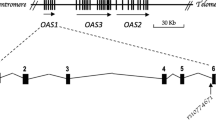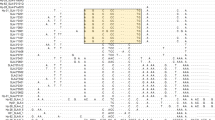Abstract
Susceptibility to scrapie is mainly controlled by point mutations at the PRNP locus. However, additional quantitative trait loci (QTL) have been identified across the genome including a region in OAR18. The gene which encodes the inducible form of the cytoplasmic Hsp90 chaperone (HSP90AA1) maps within this region and seems to be associated with the resistance/susceptibility to scrapie in sheep. Here, we have analyzed several polymorphisms which were previously described in the ovine HSP90AA1 5′ flanking region and in intron 10 in two naturally scrapie infected Romanov sheep populations. First, we have studied 58 ARQ/VRQ animals pertaining to the sire family where the QTL influencing scrapie incubation period in OAR18 was detected. We have found a significant association between polymorphisms localized at −660 and −528 in the HSP90AA1 5′ flanking region and the scrapie incubation period. These two polymorphisms have also been studied in a second sample constituted by 62 VRQ/VRQ sheep showing an extreme incubation period. Results are concordant with the first dataset. Finally, we have studied the HSP90AA1 expression in scrapie and control animals (N = 41) with different HSP90AA1 genotypes by real time PCR on blood samples. The HSP90AA1 expression rate was equivalent in CC−600AA−528 and CG−600AG−528 scrapie resistant animals (ARR/ARR) and was higher in their CC−600AA−528 than in their CG−600AG−528 scrapie susceptible counterparts (VRQ/VRQ). Our results support the hypothesis that the ovine HSP90AA1 gene acts as a modulator of scrapie susceptibility, contributing to the observed differences in the incubation period of scrapie infected animals with the same PRNP genotype.

Similar content being viewed by others
References
Bai L, Logsdon C, Merchant JL (2002) Regulation of epithelial cell growth by ZBP-89: potential relevance in pancreatic cancer. International Journal of Gastrointestinal Cancer 31:79–88
Bai L, Merchant JL (2001) ZBP-89 promotes growth arrest through stabilization of p53. Mol Cell Biol 21:4670–4683
Bai L, Merchant JL (2003) Transcription factor ZBP-89 is required for STAT1 constitutive expression. Nucl Acids Res 31:7264–7270
Basler K, Oesch B, Scott M, Westaway D, Walchli M, Groth DF, McKinley MP, Prusiner SB, Weissmann C (1986) Scrapie and cellular PrP isoforms are encoded by the same chromosomal gene. Cell 46:417–428
Baylis M, Chihota C, Stevenson E, Goldmann W, Smith A, Sivam K, Tongue S, Gravenor MB (2004) Risk of scrapie in British sheep of different prion protein genotype. J Gen Virol 85:2735–2740
Carlson GA, Goodman PA, Lovett M, Taylor BA, Marshall ST, Peterson-Torchia M, Westaway D, Prusiner SB (1988) Genetics and polymorphism of the mouse prion gene complex: control of scrapie incubation time. Mol Cell Biol 8:5528–5540
DeArmond SJ, Prusiner SB (1995) Etiology and pathogenesis of prion diseases. Am J Pathol 146:785–811
Deleault NR, Lucassen RW, Supattapone S (2003) RNA molecules stimulate prion protein conversion. Nature 425:717–720
Diaz C, Vitezica ZG, Rupp R, Andreoletti O, Elsen JM (2005) Polygenic variation and transmission factors involved in the resistance/susceptibility to scrapie in a Romanov flock. J Gen Virol 86:849–857
Dickinson AG (1975) Host-pathogen interactions in scrapie. Genetics 79(Suppl):387–395
Dickinson AG, Outram GW (1988) Genetic aspects of unconventional virus infections: the basis of the virino hypothesis. Ciba Found Symp 135:63–83
Elsen JM, Amigues Y, Schelcher F, Ducrocq V, Andreoletti O, Eychenne F, Khang JV, Poivey JP, Lantier F, Laplanche JL (1999) Genetic susceptibility and transmission factors in scrapie: detailed analysis of an epidemic in a closed flock of Romanov. Arch Virol 144:431–445
Goldmann W (2008) PrP genetics in ruminant transmissible spongiform encephalopathies. Vet Res 39:30
Jones GW, Tuite MF (2005) Chaperoning prions: the cellular machinery for propagating an infectious protein? Bioessays 27:823–832
Lander ES, Green P (1987) Construction of multilocus genetic linkage maps in humans. PNAS 84:2363–2367
Lasmezas CI (2003) The transmissible spongiform encephalopathies. Rev Sci Tech Off Int Epizoot 22:23–36
Livak KJ, Schmittgen TD (2001) Analysis of relative gene expression data using real-time quantitative PCR and the 2(-Delta Delta C(T)) Method. Methods 25:402–408
Lyahyai J, Bolea R, Serrano C, Monleon E, Moreno C, Osta R, Zaragoza P, Badiola JJ, Martin-Burriel I (2006) Correlation between Bax overexpression and prion deposition in medulla oblongata from natural scrapie without evidence of apoptosis. Acta Neuropathol 112:451–460
Lloyd SE, Onwuazor ON, Beck JA, Mallinson G, Farrall M, Targonski P, Collinge J, Fisher EM (2001) Identification of multiple quantitative trait loci linked to prion disease incubation period in mice. Proc Natl Acad Sci USA 98:6279–6283
Lloyd SE, Uphill JB, Targonski PV, Fisher EM, Collinge J (2002) Identification of genetic loci affecting mouse-adapted bovine spongiform encephalopathy incubation time in mice. Neurogenetics 4:77–81
Manolakou K, Beaton J, McConnell I, Farquar C, Manson J, Hastie ND, Bruce M, Jackson IJ (2001) Genetic and environmental factors modify bovine spongiform encephalopathy incubation period in mice. PNAS 98:7402–7407
Marcos-Carcavilla A, Calvo JH, González C, Moazami-Goudarzi K, Laurent P, Bertaud M, Hayes H, Beattie AE, Serrano C, Lyahyai J, Martin-Burriel I, Serrano M (2008) Structural and functional analysis of the HSP90AA1 gene: distribution of polymorphisms among sheep with different responses to scrapie. Cell Stress Chaperones 13:19–29
Marcos-Carcavilla A, Mutikainen M, González C, Calvo JH, Kantanen J, Sanz A, Marzanov NS, Pérez-Guzmán MD, Serrano M (2009) A SNP in the HSP90AA1 gene 5′ flanking region is associated with the adaptation to differential thermal conditions in the ovine species. Cell Stress & Chaperones, doi:10.1007/s12192-009-0123-z
Moreno CR, Cosseddu GM, Andreoletti IO, Schibler L, Roig A, Moazami-Goudarzi K, Echeynne F, Lajous D, Schelcher F, Cribiu EP, Vaiman D, Elsen JM (2003a) Identification of quantitative trait loci (QTL) modulating prion incubation period in sheep. (Identification de QTL affectant la durée d'incubation de la tremblante chez les ovins.). Toulouse: Proceedings of the International Workshop on Major Genes and QTL in Sheep and Goat
Moreno CR, Lantier F, Lantier I, Sarradin P, Elsen JM (2003b) Detection of new quantitative trait Loci for susceptibility to transmissible spongiform encephalopathies in mice. Genetics 165:2085–2091
Moreno CR, Cosseddu GM, Schibler L, Roig A, Moazami-Goudarzi K, Andreoletti O, Eychenne F, Lajous D, Schelcher F, Cribiu EP, Laurent P, Vaiman D, Elsen JM (2008) Identification of new quantitative trait Loci (other than the PRNP gene) modulating the scrapie incubation period in sheep. Genetics 179:723–726
Oesch B, Westaway D, Walchli M, McKinley MP, Kent SB, Aebersold R, Barry RA, Tempst P, Teplow DB, Hood LE, Prusiner SB, Weissmann C (1985) A cellular gene encodes scrapie PrP 27–30 protein. Cell 40:735–746
Prusiner SB (1982) Novel proteinaceous infectious particles cause scrapie. Science 216:136–144
Prusiner SB (1998) Prions. PNAS 95:13363–13383
Remington MC, Tarle SA, Simon B, Merchant JL (1997) ZBP-89, a Kruppel-type zinc finger protein, inhibits cell proliferation. Biochem Biophys Res Commun 237:230–234
SAS Institute (1990) SAS/STAT user’s guideline. SAS, Cary
Stephenson DA, Chiotti K, Ebeling C, Groth D, DeArmond SJ, Prusiner SB, Carlson GA (2000) Quantitative trait loci affecting prion incubation time in mice. Genomics 69:47–53
Tamgüney G, Giles K, Glidden DV, Lessard P, Wille H, Tremblay P, Groth DF, Yehiely F, Korth C, Moore RC, Tatzelt J, Rubinstein E, Boucheix C, Yang X, Stanley P, Lisanti MP, Dwek RA, Rudd PM, Moskovitz J, Epstein CJ, Cruz TD, Kuziel WA, Maeda N, Sap J, Ashe KH, Carlson GA, Tesseur I, Wyss-Coray T, Mucke L, Weisgraber KH, Mahley RW, Cohen FE, Prusiner SB (2008) Genes contributing to prion pathogenesis. J Gen Virol 89:1777–1788
Wagner BJ, Hayes TE, Hoban CJ, Cochran BH (1990) The SIF binding element confers sis/PDGF inducibility onto the c-fos promoter. Embo J 9:4477–4484
Wang XD, Chen XM, Wang JZ, Hong Q, Feng Z, Fu B, Zhou F, Wang FY, Fan DM (2006) Signal transducers and activators of transcription 3 mediates up-regulation of angiotensin II-induced tissue inhibitor of metalloproteinase-1 expression in cultured human senescent fibroblasts. Chin Med J 119:1094–1102
Weissmann C (1991) A ‘unified theory’ of prion propagation. Nature 352:679–683
Westaway D, Goodman PA, Mirenda CA, McKinley MP, Carlson GA, Prusiner SB (1987) Distinct prion proteins in short and long scrapie incubation period mice. Cell 51:651–662
Yamada A, Takaki S, Hayashi F, Georgopoulos K, Perlmutter RM, Takatsu K (2001) Identification and characterization of a transcriptional regulator for the lck proximal promoter. J Biol Chem 276:18082–18089
Zeiler B, Adler V, Kryukov V, Grossman A (2003) Concentration and removal of prion proteins from biological solutions. Biotechnol Appl Biochem 37:173–182
Zhang X, Diab IH, Zehner ZE (2003) ZBP-89 represses vimentin gene transcription by interacting with the transcriptional activator, Sp1. Nucl Acids Res 31:2900–2914
Acknowledgments
We thank Langlade farm for kindly providing animal samples. This work was supported by the RTA2006-00104 INIA project.
Author information
Authors and Affiliations
Corresponding author
Rights and permissions
About this article
Cite this article
Marcos-Carcavilla, A., Moreno, C., Serrano, M. et al. Polymorphisms in the HSP90AA1 5′ flanking region are associated with scrapie incubation period in sheep. Cell Stress and Chaperones 15, 343–349 (2010). https://doi.org/10.1007/s12192-009-0149-2
Received:
Revised:
Accepted:
Published:
Issue Date:
DOI: https://doi.org/10.1007/s12192-009-0149-2




